- The author visited
Chiplun in the Konkan part of Western Ghats and shares experiences including nature
and history plus temples. All this with lovely pictures.
Chiplun was recently in the news, and for
the wrong reasons. People would remember the July 2021 visuals on television of
state transport buses drowned in muddy flood water and of people huddled on
rooftops to escape the fury of the infuriated Vasishthi River. Well, more about
this later.
Let us return to the main topic- Konkan
(the coastal region of Maharashtra, Goa and Karnataka) is a land of forests, mango
and coconut orchards, of winding roads and red soil, of rich biodiversity and
breathtaking landscapes, of friendly people and delicious cuisine, and most
importantly of serenity and bliss!
As a nature lover, I have been roaming
across Konkan for over twenty years. This year, my
wife and I toured the Chiplun and Guhagar talukas of Ratnagiri district for
three days starting from Dussehra.
Straddling the Sahyadri
Most of Konkan is a part
of Sahyadri (Western Ghats-a global biodiversity hotspot) in the form of the
westward offshoots of this ancient mountain range. For a person starting from
Pune on the Deccan plateau to the east of Sahyadri, the first experience of its
eastward offshoots is in the form of the Bhuleshwar sub-range as one ascends
the old Katraj Ghat. Further, travelling on the Delhi-Mumbai-Bengaluru-Chennai national
highway (NH-48), such offshoots of Sahyadri remain in sight all along on the
west, and while ascending the Khambataki Ghat, one actually traverses one of
these.
After leaving NH-48 at
Umbraj, the small Urul Ghat heralds the actual mountainous zone. The road then merges
with the Vijapur-Chiplun-Guhagar national highway (NH-166E) and follows the
meandering Koyna River till Helvak. The mountain sides that are barren or covered
with sparse dry deciduous forests till here now give way to patchy semi-evergreen
and evergreen forests as one enters the buffer zone of Sahyadri Tiger Reserve,
which straddles the crest line of the main range, and is home to mega fauna
including Tiger, Gaur, Wild Dog, Sambar, Sloth Bear and Giant Squirrel.
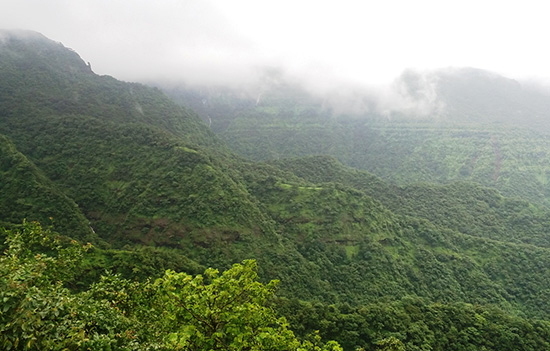 Kumbharli Ghat.
Kumbharli Ghat.
A sweeping turn and one
reaches the point where the deep valleys of Konkan nestled at the base of the
crest line suddenly come into view! The descent on the Kumbharli Ghat begins
here with feelings of awe as the massive expanse of verdant valleys becomes
visible in all its grandeur with each passing curve. This vista reminds one of the words of
Marathi poet Madhav Katdare - सह्याद्रीच्या तळी शोभते हिरवे तळकोकण, राष्ट्रदेवीचे निसर्ग निर्मित केवळ नंदनवन (The green southern Konkan adorns the base of Sahyadri,
which is indeed the lush paradise created by the guardian Devi of the country).
As the road snaked downward, we
were greeted with the melodious calls of Malabar Whistling Thrush, which added
to the charm of the mysterious monsoon atmosphere with thick clouds moving up
the crest line.
As one descends further,
the semi-evergreen forest is replaced by moist deciduous forest that typically
clothes the western sub-ranges. The ghat ends at Pophali, which houses the
power turbines of Koyna hydro-electric project. Beyond Pophali, unfolds rural
landscape of the coastal plains of houses roofed with Mangalore tiles, red soil
and chequered vegetation of mango orchards and natural forest up to Kherdi,
which houses an industrial estate, on the outskirts of Chiplun.
This town with a
population of over 50,000 is located on the banks of Vasishthi River and is
surrounded by mountains. Existing as a trading hub for centuries, today it is
gradually urbanizing as the second most populous town in Ratnagiri district;
but in a rather haphazard fashion with significant deforestation happening in
the surrounding mountains.
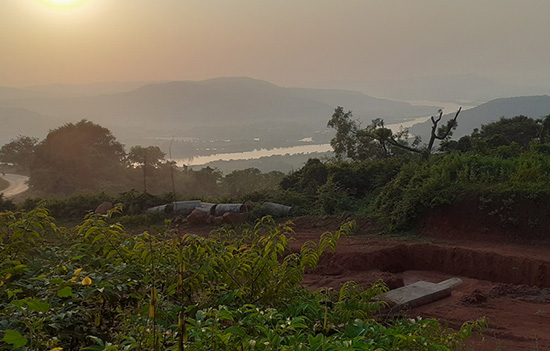 Vasishthi river Valley in evening. Pic by Madhurika Sathe.
Vasishthi river Valley in evening. Pic by Madhurika Sathe.
Green Guhagar
We were headed for the
temple town of Guhagar i.e. located on the coast, 46 km to the west of Chiplun.
The Mumbai-Goa-Kochi national highway (NH-66), which passes through Chiplun, is
also currently being widened and hectic work is on. As one moves away from the
town’s narrow roads, the verdant countryside resumes.
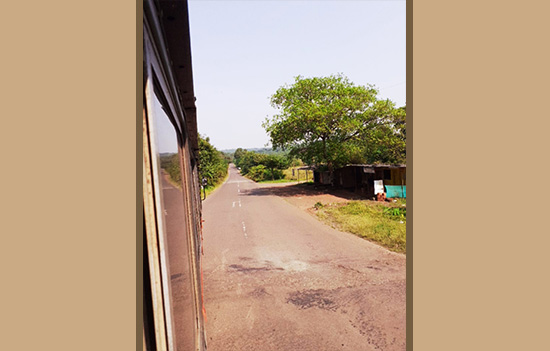 Guhanagar Chiplun road.
Guhanagar Chiplun road.
This road is a nature
lover’s paradise with miles and miles of green rolling hills and valleys dotted
with quaint villages. Most of the slopes are clothed with secondary moist
deciduous forests, and are far greener as compared to the deforested slopes
closer to Chiplun. Such landscape is typical of southern Konkan where
horticulture seamlessly merges with natural vegetation.
Locals inform that these
areas harbour wildlife such as Leopard, Giant
Squirrel, Barking Deer, Mouse Deer, Wild Boar, Golden Jackal and occasional
herds of Gaur, which are known to seasonally migrate down the main Sahyadri
range. While, these biggest of the wild cattle in the world, sometimes damage
crops, the presence of such large mammals in privately owned forests clearly
highlights the need to conserve this habitat, which hitherto was safe due to
the holistic lifestyles of the locals. A couple of remarkable examples of
sustainability in practice in the contemporary Guhagar taluka is the private
bird sanctuary of Shri Nandu Tambe and organic farm of Shri Avadhut Bhide.
The shops and stalls in
the larger wayside villages such as Marg Tamhane and Shrungartali are generally
bustling with activity, which are in stark contrast to the otherwise quiet
countryside. Further down the road a little before Guhagar, a small dam with
backwaters spreading like tentacles into the surrounding valleys in between
hills covered with a mixture of natural forest and plantations provides a
picture postcard image. Soon afterwards another small ghat crests a low
mountain and one is greeted with the seaside cosy town of Guhagar.
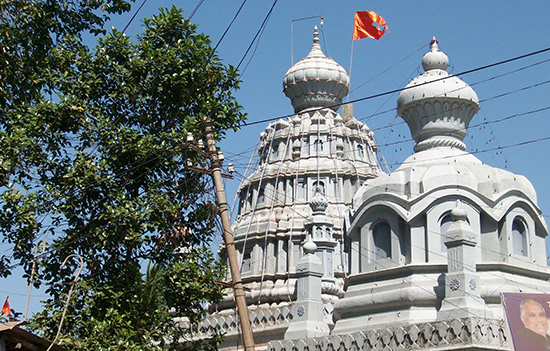 Vyadeshwar Temple, Guhagar.
Vyadeshwar Temple, Guhagar.
We had primarily come to
seek blessings of our family deity Vyadeshwar, which is a Shiv temple located
close to the sea shore. As with most temples in rural Konkan, this is a quiet
place with a rustic charm. The Garbhgruh (innermost part of a temple where the
deity resides) is tranquil and blissful with a limited number of devotees
coming on any given day. Bhagwan Shiv in the Vedic culture represents the cosmic
force that brings about a periodic recycling or restructuring for the
continuance of the universe.
My interpretation of this
energy in the natural ecosystem is that when an Elephant is partially clearing
a forested area while finding food and when a Tiger is controlling the deer
population that gives vegetation a chance to regenerate. It is actually that
force in action, which is depicted by Bhagwan Shiv in Vedic culture.
A short walk through a
plantation of Common Ironwood (popularly known as Casuarina – a name derived
from its genus) takes one to the unspoilt beach. The endless ebb and flow of
the waves is as soothing as the green forests. On one occasion I had seen a
pair of White-bellied Sea Eagle take off towards the sea, from one of the
taller trees, in search of fish.
 Harvested rice fields and coconut plantations.
Harvested rice fields and coconut plantations.
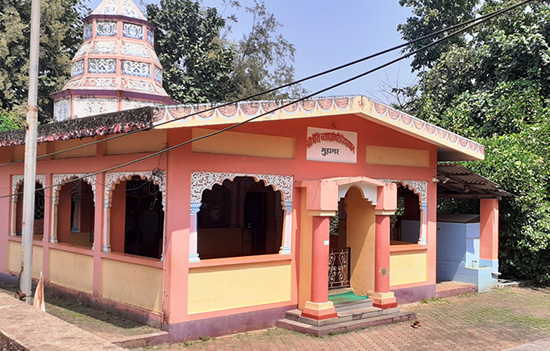 Bhairi Vyaghrambari temple. Pic by Madhurika Sathe.
Bhairi Vyaghrambari temple. Pic by Madhurika Sathe.
Our next destination in
Guhagar was Bhairi Vyaghrambari temple. On the way we passed by harvested rice
fields with Coconut plantations on the seaward side.
This temple reminds one
of Indian philosophy where all manifestations of nature are revered. It is dedicated
to Devi Vyaghrambari and teaches us to acknowledge the role of Tiger as the apex
predator in the ecosystem. Vyaghra in Samskrut is Tiger. In Guhagar taluka,
Leopard has now replaced Tiger as the apex predator.
While returning back
towards Chiplun the Sun was behind us and the sleepy countryside appeared to be
slowly preparing for the night. Looking at such an unspoilt geography from a
moving vehicle with the gentle breeze soothing one’s senses is a meditative
experience. The divinity of Devi Vyaghrambari and Bhagwan Shiv seemed to be manifesting
through this lush terrain.
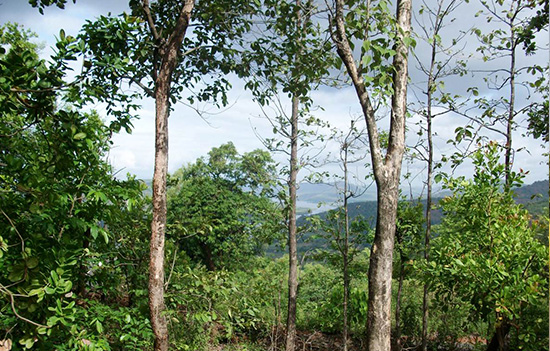 Parshuram forests.
Parshuram forests.
Picturesque Parshuram
Our final destination for
the night was the village of Parshuram nestled on the south-western slopes of
an offshoot of Sahyadri. It takes its name from the Parshuram temple and
overlooks the Chiplun valley. Parshuram Ghat on NH-66 is also being widened and
in the process the beautiful yet risky sharp curves would get smoothened out
into gentler turns, although many trees would be destroyed in the process.
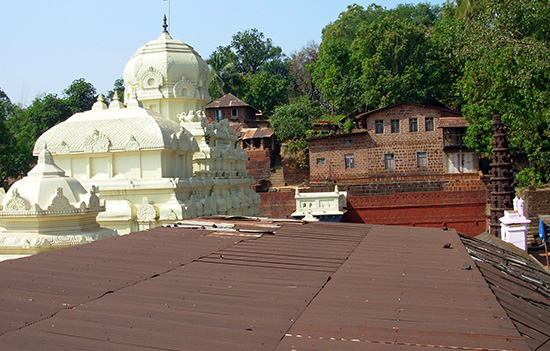 Parshuram Temple.
Parshuram Temple.
The temple dedicated to
Bhagwan Parshuram (the sixth Avatar of Bhagwan Vishnu) was built at the
initiative of Brahmendra Swami in the 17th century. The entire
temple complex esp. the Garbhgruh were peaceful and atmosphere meditative. The
serene Murtis of Parshuram, and Kaal
(the time dimension) and Kaam (desire)
on either side, both of whom were conquered by the Yogi Parshuram, are the
epitome of bliss.
Especially, if it is
raining outside, the feeling of tranquillity inside increases manifold. The
temple as well as many spots in the village and on the highway offer splendid
views of the Vasishthi River valley along with surrounding mountains. We stayed
at Amraban Resort, which also gives a bird’s eye view of the hills and dales.
Like most forested areas
of Konkan, Parshuram is rich in diversity. Over the years, I have seen and
heard dozens of species including Emerald Dove, Rufous Treepie, Barn Swallow, White-rumped
Shama, Orange-headed Ground Thrush, Malabar Whistling Thrush, Red Spurfowl,
Jungle Owlet, Common Iora, Brown-headed Barbet, White-cheeked Barbet, Common
Flameback and Jungle Nightjar, among others. Malabar Pied Hornbills are often
seen sitting on the mobile towers situated near the highway.
 Dhavji’s well. Pic by Vinay Upponi.
Dhavji’s well. Pic by Vinay Upponi.
On the road to Payarwadi,
which is higher up the mountainside, are two places worth experiencing. An old
step well called धावजी ची विहीर (Dhavji’s well) stands in utter neglect today. Ancient
cultures like India’s always used local groundwater sustainably to meet their
needs. But, the practice is slowly being lost and Dhavji’s well is a reminder. Further
ahead, near the quiet Datt temple is a natural spring, water from which is said
to have been routed to different parts of the village in the past. The stone
channels in the vicinity, which are also neglected now, testify this.
Beyond the temple, the
road passes through fairly intact moist deciduous forest for some distance. Locals
have often seen Leopards on this road, especially at night, and more so in the
post Diwali months. Mouse Deer, Grey Langur, Barking Deer and Wild Boar are
also found on the surrounding forested slopes. The predominant vegetation
comprises Teak, Mango, Indian Laurel, Bamboo, Silk Cotton, Java Plum (Jamun), Fishtail
Palm (Bherli Maad), Indraja (Pandhra Kuda), Jackfruit, Bengal Currant
(Karvand), Flame-of-the-forest and Chanda. Seasonal flowering plants such as
Silver Cockscomb (Kurdu), Blue Fountain (Bharangi), Sonki and Balsam, and ferns
decorate the slopes.
Over the years I have visited
many other places in the immediate vicinity of Parshuram and Chiplun that are a
delight to a lover of nature and history - Savatsada waterfall, Marsh Crocodile viewing from fishermen’s boats
near Songaon on the Vasishthi River, and Shivshrushti
museum depicting the life of Shivaji Maharaj and the dam surrounded by
forest in Derwan. Other places worth visiting are Vindhyavasini Hill and temple,
Gowalkot Fort and Bhavani Waghjai temple in Terav. While, Devi Bhavani is the
martial form of Devi Parvati, which in turn is that force that compliments the
Shiv energy mentioned earlier, Devi Waghjai is the
deity that initiates reverence towards big cats!
Introspection on the way home
We spent two days
experiencing the natural bounty of Parshuram and the last evening found me
sitting on a slope overlooking the NH-66 four-laning process. I had
photographed this exact location earlier when it was a two-lane affair. While
in the present situation India does need infrastructure that is sufficient to
meet the need (or greed) of people, it is worth introspecting whether this
destruction of nature is required.
Apart from loss of forest
cover, this also hampers wild animal movement. Wherever possible, it is best to
avoid mountainous or forested areas by opting for a bypass, tunnel or viaduct, as
was rightly done in the Kashedi Ghat on the same highway. Where this is not
possible, providing overpasses or underpasses for wild animals to cross over
safely is the next best option as is being done in several tiger reserves in
India. This policy that is adopted in case of government protected forests needs
to be replicated even in areas where highways pass through private forests, as
is the case in Ratnagiri and Sindhudurg districts.
Before we end, let us
revisit the issue of Vasishthi flooding. Although
the river floods every monsoon, the one witnessed this time was among the worst
in recent times. While, unplanned release of water from a dam upstream is to be
blamed according to the locals, it cannot be overlooked that rampant forest
destruction in the surrounding mountains is equally responsible as it results
in soil erosion and siltation in the river bed, thus reducing its water
carrying capacity. The deforestation is taking place for a variety of reasons ranging
from housing and tourism to reckless resource extraction.
The red soil of Konkan
and the green of its forests has been nurturing and invigorating locals and
visitors for a long time. Let us play our role in safeguarding this
biodiversity hotspot by being judicious resource consumers and responsible
visitors.
Indian culture, rooted in
centuries of sustainable living, will eventually help in finding a golden
middle path where holistic economic development reaches the masses without
destroying Mother Nature.
As we retraced our route
back to Pune, we felt blessed remembering the majestic Kumbharli Ghat, the
forests near Payarwadi and those on the road to Guhagar, the sweet notes of
Malabar Whistling Thrush and Brown-headed Barbet, and the tranquillity inside
Vyadeshwar and Parshuram temples...
Author has 18 years’ experience in the sectors of journalism, PR and environment education, and currently works as a freelance writer, communicator and educator. Unless stated all pictures by
author.